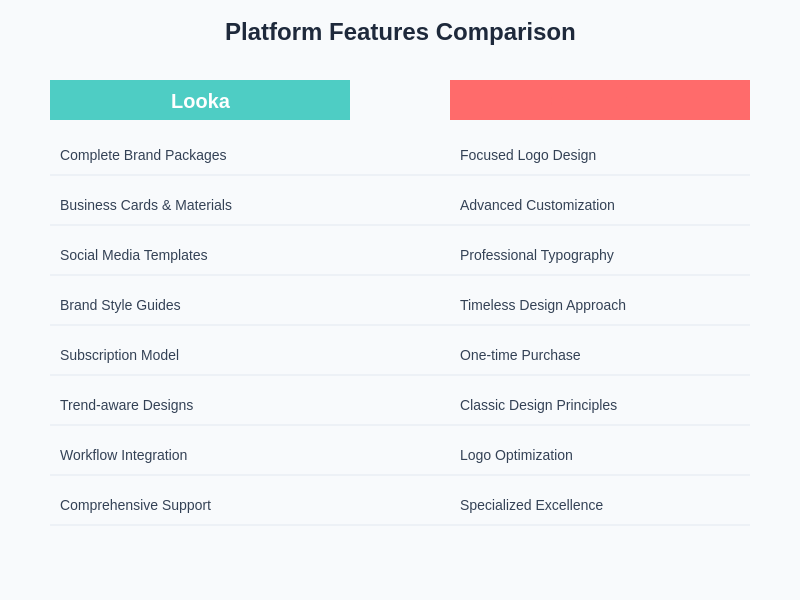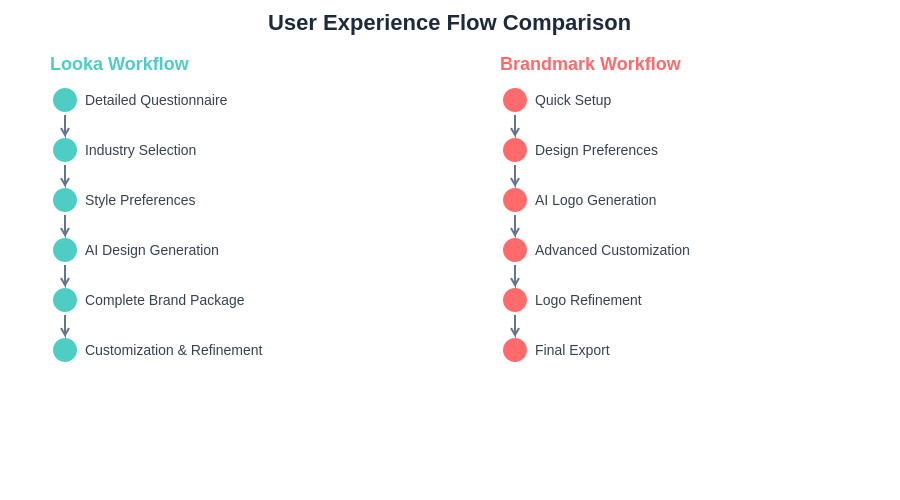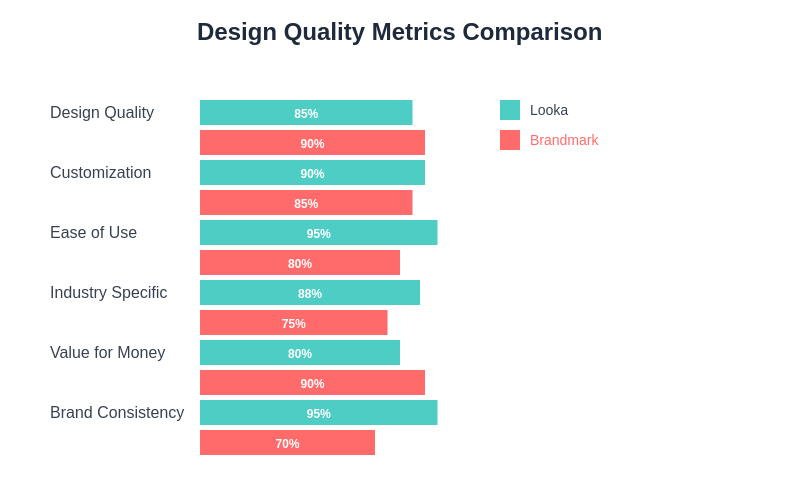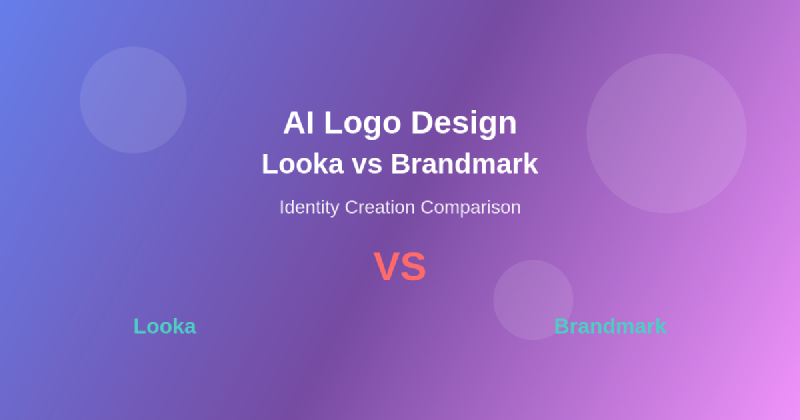The digital revolution has transformed every aspect of business operations, and brand identity creation stands as one of the most dramatically impacted domains. The emergence of artificial intelligence-powered logo design platforms has democratized professional branding, making sophisticated design capabilities accessible to entrepreneurs, small businesses, and large corporations alike. Among the leading contenders in this rapidly evolving landscape, Looka and Brandmark have established themselves as premier AI-driven logo design solutions, each offering unique approaches to automated brand identity creation that challenge traditional design methodologies.
Explore the latest AI design trends to understand how artificial intelligence is reshaping creative industries and transforming the way businesses approach visual identity development. The comparison between these two platforms reveals fundamental differences in philosophy, execution, and target audience that significantly impact the final design outcomes and overall user experience.
The Evolution of AI-Powered Brand Design
The traditional approach to logo design typically required substantial financial investment, extensive time commitments, and access to professional design expertise that many small businesses and startups found prohibitively expensive. The advent of AI-powered design platforms has fundamentally altered this landscape by leveraging machine learning algorithms, extensive design databases, and automated composition techniques to generate professional-quality logos within minutes rather than weeks. This transformation has not only reduced costs but has also introduced unprecedented levels of customization and iteration capabilities that were previously impossible within traditional design workflows.
Both Looka and Brandmark represent sophisticated implementations of AI design technology, yet they approach the challenge of automated logo creation through distinctly different methodologies. Understanding these differences becomes crucial for businesses seeking to make informed decisions about their brand identity development strategies. The platforms utilize advanced algorithms that analyze design trends, color psychology, typography principles, and industry-specific visual conventions to generate logos that align with contemporary design standards while maintaining unique brand characteristics.
Looka’s Comprehensive Brand Building Approach
Looka positions itself as a comprehensive brand building platform that extends far beyond simple logo creation to encompass complete visual identity development. The platform’s AI engine begins the design process through an interactive questionnaire that gathers detailed information about business characteristics, industry context, design preferences, and target audience demographics. This comprehensive data collection enables Looka’s algorithms to generate highly targeted design recommendations that align with specific business objectives and market positioning requirements.
The platform’s strength lies in its holistic approach to brand identity development, offering not only logo design but also complete brand packages that include business cards, social media assets, letterheads, and various marketing materials. This integrated approach ensures visual consistency across all brand touchpoints while maintaining design coherence throughout the entire brand ecosystem. Looka’s AI system continuously learns from user preferences and feedback, refining its recommendations to produce increasingly accurate and relevant design solutions that reflect contemporary design trends and industry best practices.
Enhance your design workflow with Claude’s AI capabilities for advanced creative assistance, content generation, and strategic brand development guidance that complements automated design tools. The platform’s sophisticated customization options allow users to fine-tune every aspect of their generated logos, from color schemes and typography selections to icon modifications and layout adjustments, providing extensive creative control while maintaining the efficiency benefits of AI-assisted design.
Brandmark’s Precision-Focused Design Philosophy
Brandmark adopts a more streamlined and focused approach to AI logo design, concentrating specifically on creating high-quality logos through advanced machine learning algorithms that analyze millions of existing designs to understand successful visual patterns and composition principles. The platform’s AI system employs deep learning techniques to generate original logo concepts that combine proven design elements in innovative ways, ensuring both aesthetic appeal and practical functionality across various applications and media formats.
The platform distinguishes itself through its emphasis on design quality and professional aesthetics, utilizing sophisticated algorithms that understand the nuances of typography, color harmony, and spatial relationships to create logos that meet professional design standards. Brandmark’s approach prioritizes simplicity and clarity, generating designs that work effectively across different scales and applications while maintaining visual impact and brand recognition potential. This focus on fundamental design principles ensures that generated logos possess the timeless qualities essential for long-term brand success.
The platform’s interface emphasizes ease of use without sacrificing design sophistication, guiding users through a streamlined creation process that balances simplicity with comprehensive customization options. Brandmark’s AI engine excels at understanding industry-specific design conventions while introducing creative variations that help brands stand out within their competitive landscapes. The platform’s strength lies in its ability to generate logos that appear professionally crafted while requiring minimal design expertise from users.
Comparative Feature Analysis and Capabilities
When examining the core functionality and feature sets of both platforms, significant differences emerge that reflect their distinct approaches to AI-powered design. Looka’s comprehensive platform offers extensive branding materials beyond logo creation, including business card designs, social media templates, brand style guides, and marketing collateral that maintain consistent visual identity across all applications. This breadth of offerings makes Looka particularly attractive for businesses seeking complete brand identity solutions rather than standalone logo design services.
Brandmark focuses primarily on logo excellence, dedicating its technological resources to perfecting the logo creation process rather than expanding into adjacent branding services. This specialization enables the platform to offer more sophisticated logo customization options, advanced typography controls, and refined color palette management tools that appeal to users prioritizing logo quality over comprehensive branding packages. The platform’s concentrated approach results in more polished logo outputs and greater attention to design details that impact professional presentation.

The technical capabilities of both platforms reflect their philosophical differences, with Looka emphasizing workflow integration and brand consistency while Brandmark prioritizes design refinement and logo optimization. These distinctions become particularly important when considering long-term brand development strategies and the specific requirements of different business types and industries. The comprehensive feature comparison reveals how each platform’s strengths align with different business needs and design priorities.
Design Quality and Aesthetic Considerations
The quality of AI-generated designs represents perhaps the most critical factor in platform selection, as this directly impacts brand perception and professional credibility. Looka’s designs tend to be more contemporary and trend-aware, reflecting current design movements and aesthetic preferences that appeal to modern audiences. The platform’s AI system continuously updates its design database to incorporate emerging trends, ensuring that generated logos maintain contemporary relevance while avoiding outdated visual approaches.
Brandmark’s designs typically exhibit more timeless characteristics, emphasizing classic design principles and avoiding overly trendy elements that might become dated quickly. This approach results in logos with greater longevity potential but may appear less cutting-edge compared to Looka’s more contemporary aesthetic. The platform’s focus on fundamental design principles ensures that logos remain effective across various contexts and maintain professional appearance regardless of current design trends.
Discover comprehensive AI research capabilities with Perplexity to analyze design trends, competitor branding strategies, and market positioning insights that inform logo design decisions and brand development strategies. The quality comparison between platforms often depends on specific industry requirements, target audience preferences, and long-term brand positioning objectives that influence the optimal design approach for different business contexts.
Pricing Models and Value Propositions
The economic considerations surrounding platform selection involve more than simple price comparisons, as the value propositions of Looka and Brandmark differ substantially based on their feature sets and target markets. Looka operates on a subscription-based model that provides access to comprehensive branding packages, ongoing design updates, and continuous platform improvements. This pricing structure appeals to businesses requiring extensive branding materials and long-term design support, justifying higher costs through comprehensive service offerings.
Brandmark typically employs a one-time purchase model for logo designs, with different pricing tiers corresponding to file quality, usage rights, and additional design variations. This approach attracts businesses with specific logo requirements and limited ongoing branding needs, providing clear value propositions without recurring subscription commitments. The platform’s pricing structure makes it particularly appealing for startups and small businesses operating with constrained budgets but requiring professional-quality logo designs.
The total cost of ownership considerations extend beyond initial platform fees to include potential customization requirements, additional design iterations, and long-term brand development needs that may influence the optimal platform choice for different business scenarios. Understanding these economic factors becomes crucial for making cost-effective decisions that align with both immediate design requirements and future brand development objectives.
User Experience and Interface Design
The user experience design of both platforms reflects their different approaches to AI-assisted design, with interface choices significantly impacting the overall design process and final outcomes. Looka’s interface emphasizes guided workflows that walk users through comprehensive brand development processes, providing educational content and design guidance that helps less experienced users make informed decisions about their brand identity development. The platform’s approach reduces decision paralysis while ensuring that users consider all aspects of brand consistency and visual identity coherence.
Brandmark’s interface prioritizes efficiency and direct access to core logo design functionality, appealing to users who prefer streamlined workflows without extensive guidance or educational content. The platform assumes greater user familiarity with design principles while providing powerful customization tools for users who understand how to leverage advanced design capabilities effectively. This approach results in faster design iterations for experienced users but may be less accessible for individuals with limited design background.

The learning curve associated with each platform varies significantly, with Looka providing more comprehensive onboarding and educational resources while Brandmark assumes greater user autonomy and design knowledge. These differences impact user satisfaction and design outcomes, particularly for businesses with varying levels of design expertise and different requirements for guidance throughout the creation process. The workflow comparison illustrates how each platform’s approach to user experience reflects their underlying design philosophy and target audience preferences.
Industry-Specific Design Capabilities
Different industries require distinct approaches to logo design, incorporating specific visual conventions, regulatory considerations, and audience expectations that impact design effectiveness. Looka’s comprehensive industry database enables the platform to generate designs that align with sector-specific requirements while incorporating contemporary design elements that appeal to modern audiences. The platform’s ability to understand industry contexts results in more appropriate design recommendations that consider both aesthetic appeal and functional requirements.
Brandmark’s approach to industry-specific design focuses on fundamental design principles that transcend specific sectors while maintaining professional appearance and broad applicability. This universal approach creates logos that work effectively across different contexts but may lack the specialized characteristics that help businesses connect with industry-specific audiences. The platform’s strength lies in creating versatile designs that maintain effectiveness regardless of specific industry requirements.
The importance of industry-appropriate design cannot be overstated, as different sectors have established visual conventions and audience expectations that significantly impact brand perception and market acceptance. Understanding how each platform addresses these requirements becomes crucial for businesses operating in specialized industries or targeting specific demographic segments with particular aesthetic preferences.
Customization Flexibility and Creative Control
The extent of customization capabilities directly impacts user satisfaction and design outcomes, as businesses require different levels of creative control over their brand identity development. Looka provides extensive customization options across all elements of generated designs, enabling users to modify colors, fonts, layouts, icons, and supporting brand materials while maintaining visual consistency throughout the complete brand package. This comprehensive approach to customization ensures that users can achieve their specific vision while benefiting from AI-assisted design optimization.
Brandmark offers sophisticated logo-specific customization tools that provide precise control over typography, color relationships, icon modifications, and compositional elements. The platform’s focused approach to customization enables more detailed refinement of logo designs while maintaining design integrity and professional appearance. Users can achieve high levels of personalization without compromising the fundamental design principles that ensure logo effectiveness across different applications.
The balance between automated design assistance and user control represents a crucial consideration in platform selection, as different businesses require varying levels of creative input and design modification capabilities. Understanding these customization options helps ensure that chosen platforms can accommodate specific brand requirements and creative preferences while maintaining design quality and professional standards.
Integration Capabilities and Workflow Compatibility
Modern businesses require design solutions that integrate seamlessly with existing workflows, marketing systems, and brand management processes. Looka’s comprehensive platform approach includes integration capabilities with popular business tools, social media platforms, and marketing automation systems that facilitate efficient brand deployment across multiple channels. The platform’s focus on complete brand ecosystems ensures that generated designs can be effectively implemented throughout comprehensive marketing strategies.
Brandmark’s specialized focus on logo design results in streamlined file delivery and format options that facilitate easy integration with various design software, printing systems, and digital marketing platforms. The platform’s emphasis on technical excellence ensures that delivered logo files meet professional standards for different applications while maintaining quality across various output formats and sizes.
The technical specifications and file formats provided by each platform impact long-term usability and professional application of generated designs. Understanding these technical considerations becomes crucial for businesses with specific output requirements or existing design workflows that must accommodate AI-generated brand materials.
Performance Metrics and Success Indicators
Evaluating the effectiveness of AI logo design platforms requires consideration of multiple performance indicators that reflect both immediate design quality and long-term brand success. Looka’s comprehensive approach enables measurement of brand consistency across multiple touchpoints, user engagement with complete brand packages, and the effectiveness of integrated branding strategies in achieving business objectives. The platform’s broad scope provides opportunities for comprehensive brand performance analysis.
Brandmark’s focused approach to logo design enables more concentrated evaluation of logo-specific metrics such as recognition rates, scalability effectiveness, and professional appearance across different applications. The platform’s specialization allows for detailed analysis of logo performance characteristics that directly impact brand recognition and market positioning effectiveness.

The long-term success of AI-generated designs depends on factors including market acceptance, brand recognition development, and adaptability to changing business requirements that may not be immediately apparent during the initial design process. Understanding these success indicators helps businesses make informed decisions about platform selection and design strategies that support long-term brand development objectives. The quantitative analysis demonstrates how each platform excels in different aspects of the design and user experience spectrum.
Future Developments and Technology Evolution
The rapid evolution of AI technology continues to enhance the capabilities of automated design platforms, with both Looka and Brandmark investing in advanced machine learning algorithms, expanded design databases, and improved user experience features. Looka’s development roadmap emphasizes enhanced integration capabilities, more sophisticated brand strategy guidance, and expanded customization options that support comprehensive brand development across multiple business contexts.
Brandmark’s technology development focuses on improved design algorithm sophistication, enhanced customization precision, and expanded output format options that support professional design applications. The platform’s concentrated approach enables more rapid advancement in logo-specific capabilities while maintaining focus on core design excellence and user experience optimization.
The future landscape of AI-powered design will likely see continued convergence of advanced machine learning capabilities with human creative input, creating hybrid solutions that combine the efficiency of automated design generation with the strategic insight and creative vision that human designers provide. Understanding these technological trends helps businesses make forward-looking decisions about design platform investments and brand development strategies.
Strategic Recommendations and Platform Selection
The choice between Looka and Brandmark ultimately depends on specific business requirements, budget considerations, design expertise levels, and long-term brand development objectives that vary significantly across different organizations and industries. Looka’s comprehensive approach makes it ideal for businesses seeking complete brand identity solutions with extensive supporting materials and ongoing brand development support. The platform’s integrated approach justifies higher costs through comprehensive value delivery and long-term brand consistency.
Brandmark’s specialized focus makes it optimal for businesses prioritizing logo excellence over comprehensive branding packages, particularly those with existing brand infrastructure or specific logo requirements without extensive additional branding needs. The platform’s cost-effective approach and design quality focus appeal to budget-conscious businesses that require professional logo designs without comprehensive brand development services.
The decision-making process should consider not only immediate design requirements but also long-term brand evolution needs, potential expansion into additional markets, and changing business objectives that may influence future branding requirements. Making informed platform selections requires careful evaluation of both current needs and anticipated future developments that impact brand strategy and visual identity requirements.
Conclusion and Industry Impact
The emergence of AI-powered logo design platforms like Looka and Brandmark represents a fundamental shift in how businesses approach brand identity development, democratizing access to professional design capabilities while maintaining quality standards that support effective brand communication. These platforms have successfully bridged the gap between expensive professional design services and ineffective DIY solutions, creating accessible pathways for businesses of all sizes to develop compelling visual identities that support their market positioning and business objectives.
The continued evolution of AI design technology promises even greater capabilities in the future, with enhanced personalization, improved industry-specific optimization, and more sophisticated integration with comprehensive marketing and brand management systems. Understanding the strengths and limitations of current platforms helps businesses make informed decisions while preparing for future developments that will further transform the landscape of automated design services.
The success of AI-powered design platforms ultimately depends on their ability to balance automated efficiency with creative excellence, providing users with powerful tools that enhance rather than replace human creativity and strategic thinking in brand development processes. The future of brand identity creation lies in intelligent collaboration between artificial intelligence capabilities and human insight, creating solutions that combine technological efficiency with strategic vision and creative excellence.
Disclaimer
This article is for informational purposes only and does not constitute professional design or business advice. The comparisons and recommendations are based on publicly available information and general industry analysis. Readers should conduct their own research and consider their specific business requirements when selecting design platforms or services. The effectiveness of AI design tools may vary depending on individual needs, industry requirements, and specific use cases. Pricing and features mentioned are subject to change by the respective platforms.
